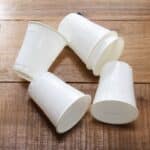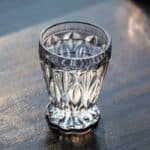
Sponges can develop unpleasant odors and harbor bacteria after a while. Microwaving a sponge is a quick and easy way to disinfect it so you can keep using the same sponge safely.
Read on to learn more about how long to microwave a sponge to disinfect it and whether microwaving it is sufficient.
Jump to:
Kitchen Sponges and Bacteria

Sponges are the perfect environment for bacteria to thrive. They usually stay damp, and their foamy structure can trap food debris and cause bacteria to develop. A sponge can contain as many as 54 billion bacteria per cubic centimeter or 0.06 cubic inches.
To give you an idea, a sponge with standard dimensions like 6x4x2” has a volume of 48 cubic inches or 786 cubic centimeters. If each cubic centimeter can become home to 54 billion bacteria, the entire sponge can contain more than 42,000 bacteria.
The good news is most of these organisms are harmless. There is less than 1% of all known types of bacteria that can cause illness in humans.
Bacteria are only one of the reasons why you need to clean your kitchen sponge regularly. Sponges can pick up other foodborne pathogens, including viruses and parasites. They can also become a breeding ground for mold and yeast.
Does Microwaving a Sponge Really Work?
In 2007, the USA Agricultural Research Service conducted a study to determine whether microwaving could kill bacteria in kitchen sponges.
Researchers found that microwaving a sponge for a few minutes could eliminate 99.99999% of bacteria. Microwaving the sponges also significantly reduces the presence of yeast and mold spores to less than 1% of their initial levels.
How Long to Microwave Sponge?

Microwaves warm up food by causing water molecules to vibrate. When these molecules vibrate, they emit heat that cooks the food you’re microwaving.
When you place a sponge in the microwave, make sure it contains moisture by letting it soak in a bowl of clean water or running it under the kitchen faucet for a few seconds.
It should take two minutes to get these water molecules to vibrate fast enough to reach a boiling temperature and kill bacteria, mold spores, and yeast.
If you’re microwaving a kitchen sponge that is thicker than standard sponges, you can microwave it for three to four minutes to make sure you disinfect it properly. You can also add a few minutes if your sponge is smelly.
How Often Should You Microwave Your Kitchen Sponge?
Ideally, you should replace your old kitchen sponge every week or every two weeks. You should replace it sooner if you notice an unpleasant smell or if the sponge looks damaged.
You should also replace your kitchen sponge more frequently if you cook meals at home several times a day and do the dishes two or three times a day.
If you want to disinfect your kitchen sponge instead of replacing it, get into the habit of microwaving it once a week to get rid of bacteria. Microwaving your sponge is a good way to disinfect it, but it doesn’t mean your sponge will last forever. You should still replace it after two to three weeks of use.
It’s also a good idea to disinfect your kitchen sponge so you can reuse it. It’s more hygienic to use a brand new sponge to do the dishes and reuse the old sponge that you disinfected in other areas of your home where you don’t prepare food.
How Do You Disinfect a Sponge in the Microwave?

There are different methods you can use to clean your kitchen sponge in the microwave.
Quick and Easy Way
Disinfecting your kitchen sponge only takes two minutes with this method:
- Let the sponge absorb some clean water.
- Place it on a plate or on another microwave-safe dish.
- Microwave it for two minutes.
- You’re done!
Advanced Cleaning
If you have a smelly sponge or want to make sure you get rid of as many bacteria as possible, you can immerse the sponge in water instead:
- Fill a bowl with some clean water.
- Immerse the sponge in the water
- Microwave the bowl for four to five minutes to get the water to reach its boiling point.
- Let the bowl cool off before you touch it.
Using Water and Vinegar
White vinegar contains acetic acid, an acid that can kill bacteria as well as break down oil and films. If you have a dirty sponge with a film on it, using a mix of water and white vinegar is a great way to disinfect it:
- Dilute the white vinegar in water. Prepare a solution with one part warm water and one part white vinegar.
- Immerse your kitchen sponge in this solution.
- Microwave the solution for two to three minutes.
Is It Safe to Microwave Your Sponge?

The answer is yes. It’s safe to microwave your sponge, as long as they use materials like polyester and polyurethane. Polyester is the soft yellow material while polyurethane is the abrasive side of the sponge.
Microwaving a kitchen sponge is generally safe, but there are a few things to keep in mind.
The sponge needs to absorb as much water as possible. If the sponge is too dry, the plastic materials will burn. Burning plastic is dangerous since it can release toxic gasses. Plus, the unpleasant smell can linger in your microwave.
Sponges with a polyurethane side have a higher risk of burning or melting since the abrasive side doesn’t retain water well. If you’re disinfecting a sponge with an abrasive side, it’s best to immerse it in a bowl of water.
It’s also important to keep an eye on the sponge you’re microwaving. If it’s your first time disinfecting a sponge in the microwave, do it in short bursts of 30 seconds, and make sure the sponge has enough moisture to continue microwaving it.
Is It Safe to Microwave a Sponge with Scotch-Brite?
Yes! Scotch-Brite sponges typically have a green abrasive side made from recycled plastic. It’s safe to microwave these sponges as long as you immerse them in water to make sure the abrasive side has enough moisture.
Which Sponges Aren’t Safe to Microwave?
You should avoid microwaving sponges that contain metal. Stainless steel sponges and scrub sponges with a steel pad aren’t safe to microwave.
Microwaving a sponge that contains metal will cause a fire in your microwave. If you’re not sure whether a sponge contains metal, it’s best not to microwave it.
Other Methods of Disinfecting Kitchen Sponges

Using your microwave is a quick and easy way to disinfect a kitchen sponge, but there are other methods you can use.
Vinegar
You can let a sponge soak in white vinegar for five minutes to eliminate bacteria. This method can help eliminate strong smells but it’s not an EPA-approved disinfectant because it’s not strong enough to kill over 99% of bacteria.
Vinegar can be a good way to extend the lifespan of a kitchen sponge, but it’s not as effective as other methods.
Bleach
Bleach is another cleaning method that researchers tested in the 2007 study from the USDA Agricultural Research Service we mentioned above.
Scientists found that a bleach solution could eliminate 37 to 87% of bacteria. The results will vary depending on how concentrated the bleach solution is and on the type of bacteria you’re dealing with.
Bleach doesn’t work as well as microwaving your sponge, but it’s better than not cleaning your sponge.
According to the CDC, you should dilute bleach in a water solution. You can use four teaspoons of bleach for each quart of water or add five tablespoons to a gallon of water.
Let your kitchen sponge soak for at least five minutes in this bleach solution before rinsing it thoroughly.
Note that you shouldn’t microwave the bleach solution. Heating water helps kill more bacteria, but heating bleach can result in bleach particles dispersing throughout your microwave. Bleach can damage the plastic inside of your microwave and make it brittle.
Dishwasher
The 2007 study from the USDA Agricultural Research Service also looked at how well a dishwasher can disinfect sponges.
The study found that a dishwasher cycle could kill 99.9998% of bacteria. This number is comparable to the results you can get with a microwave, and it’s much higher than if you were to use bleach or vinegar to disinfect a sponge.
You’ll get better results if you use a drying cycle. Disinfecting your sponges in the dishwasher is convenient since you can clean them along with your dishes. It’s also a great way to get rid of unpleasant smells.
The downside of using a dishwasher to clean your kitchen sponges is that the water pressure and cleaning cycle will likely damage the foamy structure of the sponge and cause it to fall apart sooner.
Conclusion
Now that you know more about how long to microwave a sponge and the best techniques to use, you should be able to disinfect your kitchen sponges regularly. Microwaving a sponge only takes a couple of minutes and eliminates almost all bacteria. It’s a quick and easy way to prevent bacteria, foodborne pathogens, and mold from growing and spreading.




